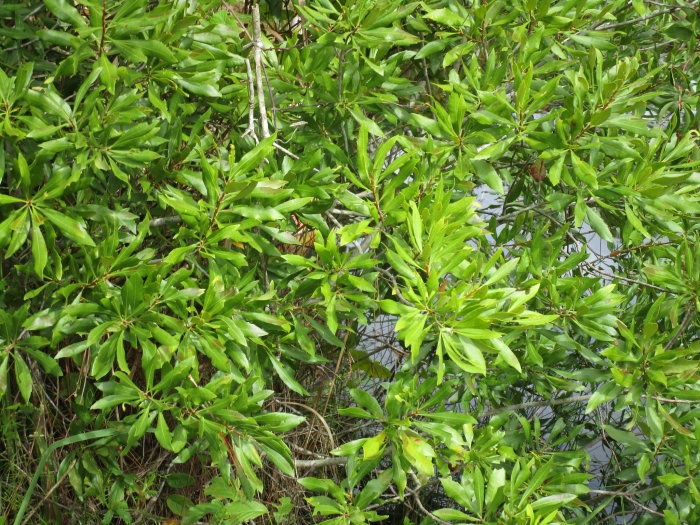Wax Myrtle
(Morella cerifera)
Wax Myrtle (Morella cerifera)
/
/

geosesarma
CC BY 4.0
Image By:
geosesarma
Recorded By:
Copyright:
CC BY 4.0
Copyright Notice:
Photo by: geosesarma | License Type: CC BY 4.0 | License URL: http://creativecommons.org/licenses/by/4.0/ | Rights Holder: geosesarma | Publisher: iNaturalist | Date Created: 2021-08-14T10:22:21-07:00 |























































Estimated Native Range
Summary
Morella cerifera, commonly known as Wax Myrtle, is an evergreen shrub or small tree native to coastal plains, marsh edges, and pine barrens in the Southeastern USA, extending to the Caribbean and Central America. It typically grows to a height of 3-6 meters (10-20 feet) with a similar spread, though it can reach up to 14 meters tall in ideal conditions. The plant features aromatic, glossy green leaves that are lanceolate to oblanceolate with serrated margins and clusters of small, inconspicuous flowers that give way to clusters of waxy, bluish-gray berries in late summer and fall.
Wax Myrtle is valued for its dense foliage and fragrant leaves, which can be used to repel insects. It serves as an excellent screen or hedge in landscapes, and its berries are highly attractive to birds. This species is also used for erosion control due to its extensive root system. Wax Myrtle thrives in a variety of conditions, preferring full sun to part shade and is tolerant of both moist and dry soils, with a preference for acidic, well-drained soils. It is hardy in USDA zones 7 to 11, with Morella pensylvanica being a more cold-hardy substitute in zones colder than 6. While it is adaptable and can handle poor pruning practices, it benefits from occasional pruning to maintain shape and promote denser growth.CC BY-SA 4.0
Wax Myrtle is valued for its dense foliage and fragrant leaves, which can be used to repel insects. It serves as an excellent screen or hedge in landscapes, and its berries are highly attractive to birds. This species is also used for erosion control due to its extensive root system. Wax Myrtle thrives in a variety of conditions, preferring full sun to part shade and is tolerant of both moist and dry soils, with a preference for acidic, well-drained soils. It is hardy in USDA zones 7 to 11, with Morella pensylvanica being a more cold-hardy substitute in zones colder than 6. While it is adaptable and can handle poor pruning practices, it benefits from occasional pruning to maintain shape and promote denser growth.CC BY-SA 4.0
Plant Description
- Plant Type: Tree, Subshrub, Shrub
- Height: 10-15 feet
- Width: 8-10 feet
- Growth Rate: Moderate
- Flower Color: N/A
- Flowering Season: Spring
- Leaf Retention: Evergreen
Growth Requirements
- Sun: Full Sun, Part Shade
- Water: Medium
- Drainage: Fast, Medium, Slow
Common Uses
Bee Garden, Bird Garden, Butterfly Garden, Deer Resistant, Drought Tolerant, Erosion Control, Fragrant, Hedges, Low Maintenance, Rabbit Resistant, Salt Tolerant, Street Planting
Natural Habitat
Coastal plains, marsh edges, and pine barrens
Other Names
Common Names: Candleberry, Southern Bayberry, Southern Wax Myrtle, Wax-Myrtle, Waxberry, Tallow Shrub, Wachsbeerbaum, Wachsmyrte, Arrayán, Cera Vegetal
Scientific Names: , Morella cerifera, Myrica cerifera, Myrica pusilla, Myrica cerifera var. pumila, Myrica pumila, Morella pumila, Myrica mexicana, Myrica microcarpa, Myrica xalapensis
GBIF Accepted Name: Morella cerifera (L.) Small